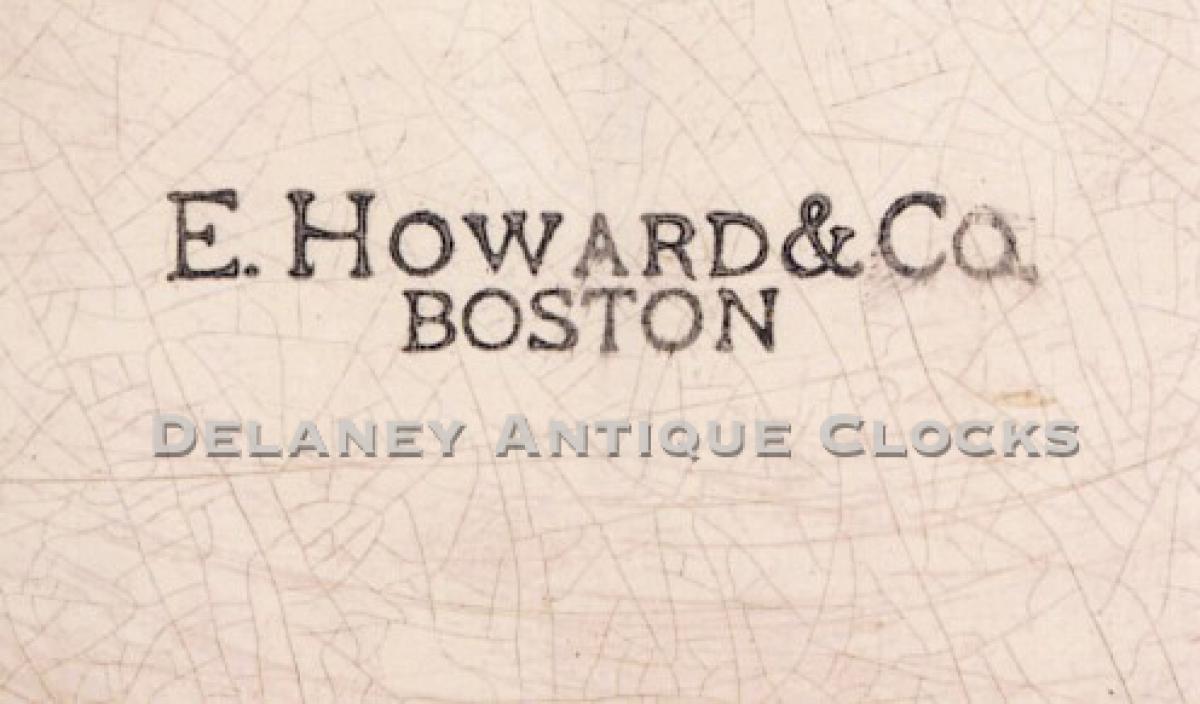E. Howard & Co. Model No. 6. Wall Regulator Figure 8. Watchman's Bank & Public Office Clock." Boston, MA. UU-21.
This Number 6 Regulator, or the "Figure Eight" form, is arguably one of the most attractive antique wall clock forms in today's marketplace. This impressive example is the largest of 5 individual sizes that share this distinctive form. This case measures 4 feet 10 inches long, 19 inches wide, and 6.75 inches deep. It is constructed in black walnut and retains an older finish. The condition of which is very good, making it a desirable example. The front of this case also serves as a door. It is hinged and swings to the right. This door is fitted with glass. The upper glass is clear, and you can view the dial through it. The middle tablet or throat glass is decorated in black and gold from the back. The center section is left clear so you can view the motion of the gilded pendulum rod. The lower circular tablet is painted in the traditional E. Howard colors of black, red, and gold. The center of this is also left clear in order to view the brass-faced pendulum bob. Both painted tablets are original to this clock. They have had some minor restoration in stabilizing the original paint.
The iron dial on this model measures 14 inches in diameter. This dial is original to this clock. The hours are indicated with Roman-style figures. The subsidiary seconds dial is divided into ten-second increments labeled in an Arabic format. The Company name is signed below the center arbor in a block letter. It reads, "E. Howard & Co., / Boston."
The time is indicated in the traditional format. The hands are designed with open diamonds out on their ends. These are original to this clock.
The weight-driven movement is constructed in brass and of very good quality. The Maker's name can be found die-stamped into the front plate. The heavy plates are rectangular in shape and are finely finished. This movement is designed to beat seconds on a Graham deadbeat escapement. It is fitted with maintaining or retaining power. This is a device that maintains power on the great wheel while in the process of winding this clock. This has two positive effects. First, it prevents the loss of impulse to the time train while winding. Secondly, it protects the teeth on the escape wheel due to the large size and weight of the 8-inch bob at the bottom of the pendulum. A Geneva stop work will prevent you from overwinding this clock. The pendulum is carefully suspended by a double suspension spring mounted to the top of the movement. The rod is made from straight-grain cherry that was appropriately seasoned and retained its' original gilding. The bob measures 8 inches in diameter. It is zinc and covered with a brass jacket for compensation. The face of the bob is decorated with several engraved concentric rings. The original cast iron weight is impressed with the number 6. This clock is designed to run for eight days on a full wind. (Please note, this clock was photographed before we serviced it.)
This example is fitted with a reconstructed wooden weight board. This board provides a guide for the weight or protection of the pendulum. It is also used as a field of color for the pendulum to swing in front of. The board is painted black.
This fine clock was made circa 1870.
Inventory number UU-21.
The E. Howard & Company succeeded the Howard & Davis firm in 1857. The Howard & Davis firm was comprised of Edward Howard and David Porter Davis and was established in 1842 in Roxbury, Massachusetts. Both men had just completed their clock apprenticeship under the guidance of Aaron Willard Jr in Boston. The Howard & Davis firm made high-grade clocks, precision balances, sewing machines, fire engines, and watches. After the dissolution of Howard & Davis, Edward Howard became Boston's leading manufacturer of weight-driven residential and commercial clocks. The firm also made a large number of tower clocks and watchman and salve clock systems. These sold well in the last quarter of the 1800s.
It has been said that the E. Howard Clock company never made an inexpensive clock, and everything they made was of very good quality. As a result, Howard clocks have become very collectible and are prized by their owners. Today, the E. Howard name enjoys outstanding name recognition.
For a more in-depth reading of Edward Howard and his various businesses, please read "Willard's Patent Time Pieces," written by Paul Foley.














